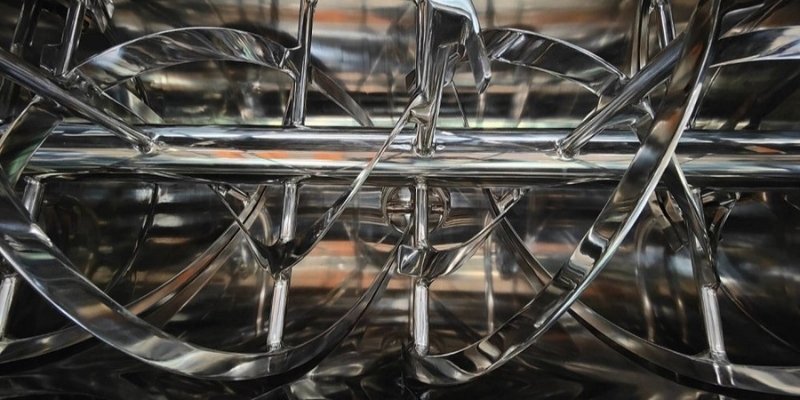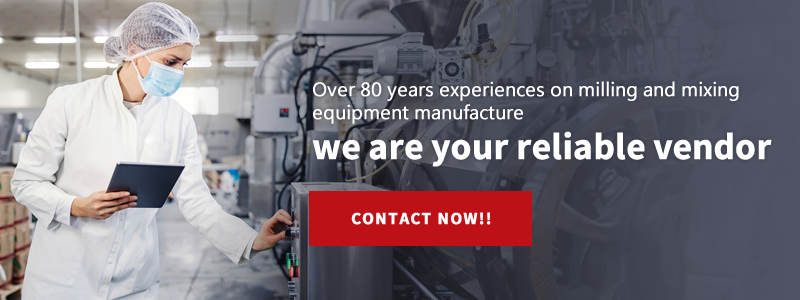- Maison
- Blog
- explication technique
- What is a Ribbon Mixer? Discover Its 3 Main Advantages and Applications
What is a Ribbon Mixer? Discover Its 3 Main Advantages and Applications

In the manufacturing and processing industries, ribbon mixers are indispensable machines that ensure different materials are thoroughly mixed. This not only streamlines production but also enhances product consistency. In this article, we’ll take a quick look at how ribbon mixers work, their three key advantages, and the industries where they are commonly used—helping you make smarter choices when selecting equipment.
What Is a Ribbon Mixer?
A ribbon mixer is a mechanical device that blends two or more raw materials evenly using mechanical force and gravity. During operation, materials are kept in continuous motion within the tank, where rotating and stirring actions mix different types of materials thoroughly. Ribbon mixers are widely used in processes requiring uniform distribution of ingredients, such as powders, liquids, or granules.
How Ribbon Mixers Work
A ribbon mixer is a common powder mixing machine that achieves its effect through double-layer spiral blades mounted on a central shaft. The outer ribbon pushes materials from both ends toward the center, while the inner ribbon moves them from the center toward both sides. This opposing flow creates a continuous circulation within the tank, resulting in uniform and convective mixing.
Top 3 Advantages of Ribbon Mixers for Optimized Processing
Advantage 1: Versatile Applications
Ribbon mixers can blend powder with powder or coat liquids evenly onto powders, offering flexibility and a wide application range. For instance, depending on the process, a ribbon mixer can be equipped with a heating system, oil spraying device, or lump breaker. This multifunctional design increases processing flexibility and mixing efficiency to meet the needs of various industries and formulas.
Advantage 2: Fast and Uniform Mixing
Compared to manual or slow mixing methods, the major advantage of a ribbon mixer is its speed and uniformity. Depending on the material and required results, mixing typically takes only a few minutes up to 20 minutes, significantly reducing overall processing time. This rapid mixing feature improves workflow and stabilizes lead times on production lines.
Advantage 3: Gentle Operation
Despite the rapid mixing results, ribbon mixers operate gently, with rotation speeds generally between 18 and 29 RPM. This prevents over-shearing or excessive collisions that may break delicate materials. The gentle operation is ideal for handling powders and materials that must retain their particle structure and quality—balancing efficiency with protection.
5 Key Industries That Rely on Ribbon Mixers
Application 1: Food Processing
Ribbon mixers are frequently used in the food processing industry to blend flour, sugar, milk powder, and other powders or granules for baking ingredients, seasoning mixes, and even infant formula. Stable mixing ensures consistent quality and meets strict safety and hygiene requirements.
<Further Reading: Understanding Hammer Mills: Operation, Advantages, Disadvantages, and Selection Criteria>
Application 2: Chemical Industry
In the chemical industry, ribbon mixers are commonly used to blend pigments, powders, and additives. Given the varied properties of chemical materials, ribbon mixers help achieve uniform blending in a short time, improving consistency and production efficiency.
<Further Reading: How to Choose a Powder Grinder: Key Principles and 3 Major Applications for Boosting Production Efficiency>
Application 3: Pharmaceutical Manufacturing
Pharmaceutical production demands high accuracy in ingredient blending. Ribbon mixers are used for mixing pharmaceutical powders, capsule ingredients, probiotics, and various medicinal powders. By precisely controlling mixing time and speed, manufacturers ensure even ingredient distribution and consistent dosages—meeting stringent quality and safety standards.
<Further Reading: Grinding Mill: Types, Applications, and Key Selection Points in 3 Minutes!>
Application 4: Construction Industry
In construction, ribbon mixers are used to mix dry mortar, pigment powders, and concrete additives. These high-density materials require dual-direction mixing to ensure fast and even blending. While ribbon mixers aren’t suitable for large-volume wet mixing like cement slurries, they are ideal for processing powder-based building materials—enhancing efficiency and stability.
Application 5: Agriculture
In agriculture, ribbon mixers are used to produce animal feed and fertilizers by evenly blending various nutrients. This ensures uniform nutrient distribution, improves feed quality and animal absorption, and enhances fertilizer performance—meeting the growth needs of both plants and animals.
<Further Reading: Comprehensive Guide to Pulverizer Applications Principles and Selection Tips>
Choose the Right Mixer—MPT Covers Efficiency, Safety, and Durability
<Recommended Product: Ribbon Mixer>
Find the Right Mixer to Boost Production and Product Quality
<Further Reading: How to Choose the Right Plastic Recycling Machine for Your Waste—Key Tips for Reduction!>
Classification des articles
Articles récents
- How to Choose a Laboratory Grinder? Types & Quick Selection Guide
- How to Choose a Plastic Grinding Machine? Master the Principles, Models, and Key Selection Points to Simplify Plastic Processing
- What is Spice Grinding? The Fineness and Method of Grinding Different Spices Can Affect Their Flavor!
- What is a Pin Mill? Understanding Its Working Principle, Advantages, and Uses!
- What is a Ribbon Mixer? Discover Its 3 Main Advantages and Applications

